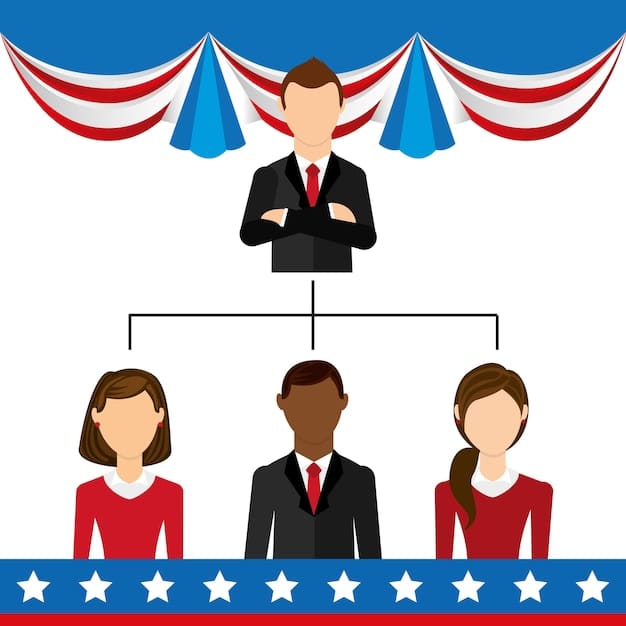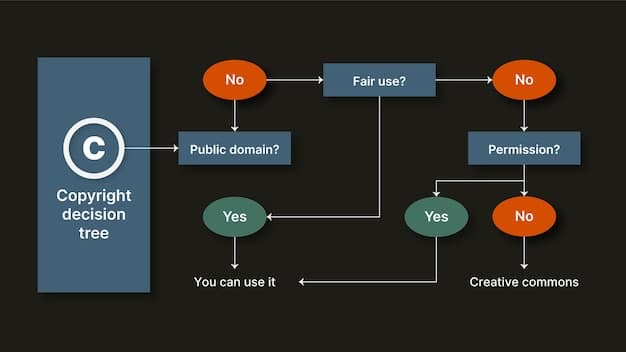Understanding Impeachment: A Step-by-Step Guide for US Citizens

Understanding the impeachment process in the United States involves a formal accusation by the House of Representatives, followed by a trial in the Senate, potentially leading to the removal of a president, federal judge, or other federal official from office.
Understanding the impeachment process: A step-by-step guide can seem daunting, but it’s a crucial part of American democracy. This article breaks down the complicated process into manageable steps, ensuring you grasp how it works and its significance in US politics.
What is Impeachment? A Clear Definition
Impeachment, often discussed but perhaps not fully understood, is a vital constitutional power. It’s a process meant to deal with high-level misconduct, ensuring that no one is above the law.
Let’s start with the basics. Impeachment isn’t a criminal conviction; it’s more like an indictment.
Impeachment vs. Conviction
The terms “impeachment” and “conviction” are often used interchangeably, but they represent distinct stages in the process. Impeachment is the formal accusation, while conviction is the outcome of the Senate trial.
- Impeachment: A formal charge of wrongdoing brought against a public official.
- Conviction: The outcome of the Senate trial, requiring a two-thirds vote for removal from office.
- Role of Congress: The House of Representatives impeaches, and the Senate conducts the trial.
Understanding this distinction is key to understanding the impeachment process. It highlights the separation of powers and the checks and balances built into the US government.
In summary, impeachment is the accusation, and conviction is the result. Both are critical components of holding public officials accountable.

Grounds for Impeachment: What Warrants Such Action?
Not just any misstep can lead to impeachment. The Constitution specifies the grounds for such action, ensuring that it’s reserved for serious offenses.
So, what exactly constitutes an impeachable offense?
“Treason, Bribery, or other high Crimes and Misdemeanors”
This phrase from the Constitution is the foundation for understanding what can lead to impeachment. It’s open to interpretation, but generally refers to abuses of power and serious misconduct.
The key terms in the constitutional phrase include:
- Treason: Betraying one’s country, typically by aiding enemies.
- Bribery: Accepting something of value to influence official actions.
- High Crimes and Misdemeanors: A broad category that includes abuse of power, obstruction of justice, and violation of public trust.
These grounds are not limited to criminal acts. They can include actions that undermine the integrity of the office and the government. Understanding the impeachment process also means understanding the breadth of these grounds.
In conclusion, the grounds for impeachment are serious and relate to the abuse of power or betrayal of public trust, not just any wrongdoing.
The Impeachment Process: A Step-by-Step Walkthrough
The impeachment process is a multi-stage procedure with specific roles for the House and Senate. It’s a complex mechanism designed to ensure fairness and due process.
Let’s break down the process step by step.

Step 1: House Investigation
The process usually begins with an investigation, often conducted by a House committee. This investigation gathers evidence and determines if there are grounds for impeachment.
During the investigation:
- The committee gathers evidence through interviews, documents, and testimonies.
- They assess whether the evidence meets the constitutional threshold for impeachment.
- If sufficient evidence is found, the committee drafts articles of impeachment.
Step 2: House Vote
If the House committee finds sufficient evidence, it presents articles of impeachment to the full House for a vote. A simple majority is required for impeachment.
During the House vote:
- The House debates the articles of impeachment.
- A simple majority vote in favor of the articles impeaches the official.
- The impeached official is then subject to a trial in the Senate.
Step 3: Senate Trial
After impeachment, the Senate holds a trial to determine whether to convict and remove the official from office. The Chief Justice of the Supreme Court presides over the trial.
During the Senate trial:
- The House appoints managers to present the case against the impeached official.
- The impeached official has the right to legal representation.
- The Senate hears evidence and arguments, and then votes on whether to convict.
Step 4: Senate Vote and Potential Conviction
A two-thirds majority in the Senate is required to convict and remove an official from office. If the Senate fails to reach this threshold, the official is acquitted.
During the Senate vote and potential conviction:
- Senators deliberate and vote on each article of impeachment.
- If at least two-thirds of the Senate votes to convict on any article, the official is removed from office.
- If the threshold is not met, the official is acquitted, and remains in office.
This step-by-step breakdown is essential for understanding the impeachment process. It emphasizes the balance of power and the importance of due process.
In summary, the impeachment process involves investigation, House vote, Senate trial, and potential conviction, with significant checks and balances at each stage.
Historical Examples of Impeachment in the US
Impeachment has been a part of the American political landscape since the founding of the country. Examining historical cases provides valuable context.
Let’s look at a few notable examples.
Andrew Johnson
In 1868, President Andrew Johnson was impeached by the House for violating the Tenure of Office Act. However, he was acquitted by the Senate by a single vote.
Richard Nixon
In 1974, President Richard Nixon faced impeachment proceedings related to the Watergate scandal. He resigned before the House could vote on the articles of impeachment.
Bill Clinton
In 1998, President Bill Clinton was impeached by the House for perjury and obstruction of justice related to his affair with Monica Lewinsky. He was acquitted by the Senate.
Donald Trump (Twice)
President Donald Trump was impeached twice. First, in 2019, for abuse of power and obstruction of Congress related to his dealings with Ukraine. Second, in 2021, for inciting an insurrection related to the January 6th Capitol attack. He was acquitted by the Senate both times.
These cases highlight the serious nature of impeachment and the political complexities involved. Studying these examples is key to truly understanding the impeachment process.
In conclusion, historical examples of impeachment demonstrate the process is reserved for significant misconduct and often involves high political stakes.
The Political Ramifications of Impeachment
Impeachment is not just a legal process; it’s a highly political one. It can have significant consequences for the president, Congress, and the nation as a whole.
So, how does impeachment affect the political landscape?
Impact on the President’s Legacy
Being impeached, regardless of the outcome of the Senate trial, can tarnish a president’s legacy. It can affect how they are viewed by history and the public.
Impact on Congress
Impeachment can also have a significant impact on Congress. It can divide parties, affect legislative agendas, and influence future elections.
- Divisions: Impeachment proceedings often exacerbate partisan divisions.
- Agendas: The process can disrupt legislative priorities and focus.
- Elections: Impeachment can influence voter behavior and election outcomes.
Impact on the Nation
Impeachment can be a divisive and traumatic experience for the nation. It can raise questions about leadership, accountability, and the rule of law.
Understanding the impeachment process involves recognizing its broader political and social implications. It’s a powerful tool that must be used judiciously.
In summary, impeachment has far-reaching political ramifications, affecting the president, Congress, and the overall stability and unity of the nation.
Criticisms and Debates Surrounding Impeachment
The impeachment process is not without its critics. There are ongoing debates about its scope, fairness, and potential for abuse.
Let’s examine some of the criticisms and debates.
Partisan Politics
One of the main criticisms is that impeachment can be driven by partisan politics. Critics argue that it can be used as a political weapon rather than a tool for accountability.
The Definition of “High Crimes and Misdemeanors”
The vague language of “high crimes and misdemeanors” is another source of debate. Some argue that it gives too much discretion to Congress, while others argue that it provides necessary flexibility.
The Impact on Presidential Power
There are concerns that the threat of impeachment could weaken the presidency and make it more difficult for presidents to govern effectively.
It is extremely important to understanding the impeachment process but also these associated criticisms and debates. It helps to appreciate the complexities and potential drawbacks of its use.
In conclusion, the impeachment process faces criticism for its potential for partisanship, the ambiguity of its grounds, and its impact on executive power.
| Key Point | Brief Description |
|---|---|
| 📜 Definition | Impeachment is a formal accusation by the House. |
| ⚖️ Grounds | Treason, bribery, or high crimes and misdemeanors. |
| 🏛️ Senate Trial | Requires a two-thirds vote for conviction. |
| 📜 Examples | Includes Andrew Johnson, Bill Clinton, and Donald Trump. |
Frequently Asked Questions
▼
The House of Representatives has the sole power to impeach federal officials. This means they are responsible for initiating the impeachment process by bringing charges against the official.
▼
The Senate has the sole power to try all impeachments. This means that after an official is impeached by the House, the Senate conducts a trial to determine whether to convict and remove the official from office.
▼
“High crimes and misdemeanors” is a phrase in the US Constitution that outlines the grounds for impeachment. It generally refers to serious abuses of power, corruption, or dereliction of duty.
▼
Yes, a president can be pardoned after being impeached and removed from office. However, the pardon would only apply to federal crimes, not to the removal from office itself.
▼
If a president is removed from office through impeachment, the Vice President assumes the presidency. This succession is outlined in the Constitution and ensures a smooth transition of power.
Conclusion
Understanding the impeachment process is essential for every US citizen. It’s a complex but vital mechanism for holding those in power accountable and safeguarding the principles of American democracy. By grasping the steps involved, the historical context, and the political implications, we can all be more informed and engaged participants in our government.





